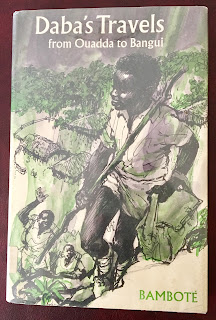READ
First things first. Where on earth is Comoros? I’d never
heard of it until I started making plans for this project. Turns out it’s an island
nation off the eastern coast of Africa, situated between Madagascar and Mozambique.
It used to be a French colony, which means that I needed to find an English
translation of a book written in French. Unfortunately, it does not appear that
any Comorian novels have ever been translated into English for commercial
publication. Hmmm, what to do?
I did what other people who have embarked on a similar global
reading project have done – I emailed an entreaty to Dr. Anis Memon, a professor at the University of Vermont who has done
his own informal translation of Mohamed Toihiri’s novel, The Kaffir of Karthala. Dr. Memon graciously emailed me a copy of
his translation, and my problem was solved.
The Kaffir of Karthala
opens with the protagonist, Dr. Idi Wa Mazamba, being told by his physician
that he has cancer and has only a year to live. He doesn’t tell his wife, with whom
he leads a fairly loveless existence. He recently met a young woman from France
and a relationship appears to be developing between them, although it is
complicated not only because he is married, but by the fact that he is a black Muslim
Comorian and she is a white Jewish European.
The book is full of descriptions of Comorian life, including
wedding customs, religious rituals, and personal relationships. As the book
proceeds, we also learn more about the government of Comoros when the
President offers Idi a position in his administration. I especially liked this
quote from Idi when he was talking to the President: “To succeed in changing
attitudes you have to begin, Mr. President, by demanding of each of your
ministers that in full council they give you a summary of the books they’ve
read this month, for the mind is like a plant: if you don’t water it, it dies.”
The author of The Kaffir of Karthala, Mohamed Toihiri, served as a Comorian diplomat. According
to Wikipedia, he was Permanent Representative to the United Nations for Comoros,
accredited as Ambassador to the United States, Canada, and Cuba, and he was also
the first published author of Comoros. I enjoyed having the opportunity to
learn about this country from a man who knows it so well.
COOK
The book mentioned a plethora of fruits and vegetables that
grow in the Comorian islands: mangoes, guavas, coconuts, bananas, litchis,
oranges, lemons, almonds, tamarind, grapefruit, wild raspberries, corn, manioc,
and breadfruit, for example. There were also some dishes that sounded like they
might possibly be vegan, if only I had been able to find recipes for the Comorian
versions of them, such as sambosas, nutmeg biryani, and halwa. I decided to
just search online for Comorian recipes, and I found one for soupe faux pois,
or sweet pea soup. The recipe was vegan as written, so I didn’t have to make
any substitutions. The soup was very tasty and a little spicy. It was not
pretty, however, as you can see in the photo below. It was supposed to be
garnished with lime slices and coconut milk, but they were too heavy to stay on
top of the soup. So those Jackson Pollack-type speckles of coconut milk are the
best I could do for the garnish. The recipe was
from a website called InternationalCuisine.com.
GIVE
Finding an organization to receive my donation for this
country was a bit of a challenge. My go-to donation website, GlobalGiving.com, didn’t have any
projects listed for Comoros, so I had to do a little Internet searching. I
found the Durrell Wildlife Conservation Trust, which works to save species from
extinction throughout the world. According to their website, Comoros and nearby
Madagascar “form part of one of the five most important areas in the world for
biodiversity.” However, many species on these islands are being threatened.
Consequently, “Durrell focuses on the most threatened species and the most
threatened habitats of Madagascar and the Comoros. Rural communities depend on
the same ecosystems for their livelihoods, so our approach is based on
empowering these communities to lead in the protection of their local
environments.” I asked that my donation be used for a project in Comoros. More
information about the Durrell Wildlife Conservation Trust can be found at https://www.durrell.org/wildlife/.
NEXT STOP: DEMOCRATIC
REPUBLIC OF CONGO






























